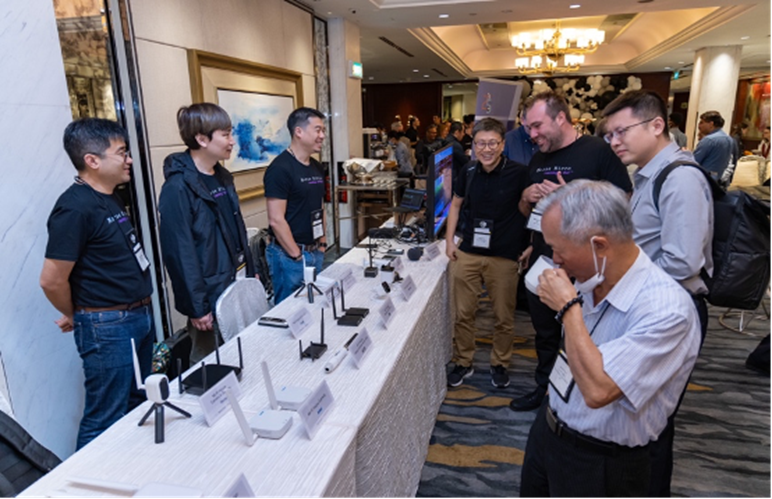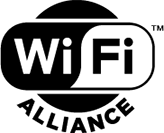The Internet of Things (IoT) ecosystem is rapidly evolving, and Wi-Fi CERTIFIED HaLow™ is here to meet the long-range, low-power connectivity demands of IoT. It is estimated that there will be 27 billion connected IoT devices deployed by 2025,[1] and a growing number of these devices will connect through Wi-Fi HaLow™ as the protocol gains traction in a variety of settings including home, enterprise, hospitality, factories, farms, and smart cities. Read on to learn how Wi-Fi HaLow is expanding IoT connectivity.
Key features and benefits of Wi-Fi HaLow
Developed specifically for IoT, Wi-Fi HaLow operates in the sub-1 GHz band to enable extended range, power efficiency, and robust security. Key features and benefits include:
- Longer range: The sub-1 GHz narrowband signals of Wi-Fi HaLow propagate more than 10 times farther than 2.4 GHz or 5 GHz Wi-Fi® signals – reaching up to 3 kilometers (km) – allowing it to cover over 100 times the area of conventional Wi-Fi.
- Power saving features: Wi-Fi HaLow allows the transfer of more bits per unit of energy than many other wireless IoT technologies. Wi-Fi HaLow also supports sleep and power management modes that enable multi-year battery operation for IoT devices with Restricted Access Window (RAW) and Target Wake Time (TWT).
- Multi-STA support: Wi-Fi HaLow distinguishes itself with the capacity to support 8,191 devices from a single access point (AP), far exceeding the network capacity of traditional Wi-Fi and other IoT protocols. This feature is crucial for the development of extensive multi-station (multi-STA) networks, where myriad IoT devices require seamless interconnectivity. It marks a significant step toward realizing dense, interconnected IoT ecosystems of the future.
- Lower path loss: Wi-Fi HaLow's use of sub-1 GHz frequencies inherently reduce path loss, ensuring greater signal penetration through barriers like walls, doors, and windows, resulting in greater coverage with fewer APs. This capability is pivotal for creating more accessible and reliable networks, particularly in environments where physical barriers traditionally impede connectivity.
- Spectral efficiency: In response to the growing issue of network congestion, Wi-Fi HaLow’s operation in the unlicensed sub-1 GHz band provides much-needed additional spectrum. By supporting orthogonal frequency-division multiple access (OFDMA) modulation in channel bandwidths down to 1 MHz, Wi-Fi HaLow significantly improves spectral efficiency compared to other IoT technologies operating in the sub-1 GHz bands. This is key for densely populated IoT environments facing bandwidth constraints.
Wi-Fi HaLow in action
In January 2024, Morse Micro successfully conducted the world's first live two-way video call demonstration of Wi-Fi HaLow technology over a 3 km distance in San Francisco's Ocean Beach neighborhood. This field test not only set a new benchmark for long-distance Wi-Fi connectivity, but also highlighted Wi-Fi HaLow's potential to offer an alternative to other longer-range, low-power wireless solutions for IoT applications. Click the link below to view the demonstration.

As further proof of the technology’s capabilities, Morse Micro showcased Wi-Fi HaLow-enabled video cameras at the Wi-Fi Alliance Member Meeting in Singapore in February 2024. Using high-resolution cameras set up outside the hotel 60 meters away from the Wi-Fi HaLow AP, the demo proved the ability of sub-GHz Wi-Fi HaLow signals to penetrate multiple concrete walls, transmitting high-res video content to a 65-inch television. The Wi-Fi HaLow demonstration succeeded while network congestion made it impractical in traditional 2.4 GHz and 5 GHz wireless bands.

The future of IoT connectivity
The rapid growth of IoT has highlighted the limitations of conventional Wi-Fi, particularly in terms of range and power efficiency. Wi-Fi HaLow addresses these issues head-on by operating on narrow frequency bands, allowing for improved penetration and performance in environments crowded with devices. Wi-Fi HaLow meets the requirements for long-range, low-power consumption, scalability, security, and robustness necessary for challenging IoT settings. Wi-Fi HaLow offers significantly extended range and coverage compared to traditional Wi-Fi, promising 10 times the range, 100 times the area coverage, and 1000 times the volume. Morse Micro is a leader in this technology with its MM6108 production silicon, certified by Wi-Fi Alliance and FCC, making it the market's most efficient Wi-Fi HaLow chip in terms of speed, size, power usage, and range.
Wi-Fi HaLow’s evolution marks a significant advancement in IoT technology, promising to enhance connectivity across a broad spectrum of applications. As Morse Micro leads the way in Wi-Fi HaLow’s development, we're committed to innovating and expanding the possibilities for IoT networks worldwide.
[1] IoT Analytics 2023
The statements and opinions by each Wi-Fi Alliance member and those providing comments are theirs alone, and do not reflect the opinions or views of Wi-Fi Alliance or any other member. Wi-Fi Alliance is not responsible for the accuracy of any of the information provided by any member in posting to or commenting on this blog. Concerns should be directed to info@wi-fi.org.




Add new comment